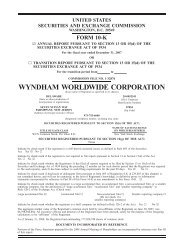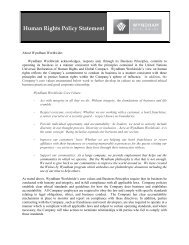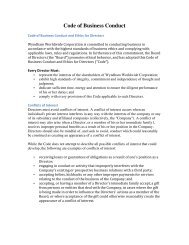WYNDHAM WORLDWIDE CORPORATION
WYNDHAM WORLDWIDE CORPORATION
WYNDHAM WORLDWIDE CORPORATION
You also want an ePaper? Increase the reach of your titles
YUMPU automatically turns print PDFs into web optimized ePapers that Google loves.
totaled less than 5% of rental transactions booked. Upon confirmation of the rental reservation, the rental customer<br />
and property owner generally have a direct relationship for additional services to be performed. The Company also<br />
earns rental fees in connection with properties it manages, operates under long-term capital leases or owns and such<br />
fees are recognized when the rental customer’s stay occurs, as this is the point at which the service is rendered. The<br />
Company’s revenues are earned when evidence of an arrangement exists, delivery has occurred or the services have<br />
been rendered, the seller’s price to the buyer is fixed or determinable, and collectability is reasonably assured.<br />
Vacation Ownership<br />
The Company develops, markets and sells VOIs to individual consumers, provides property management<br />
services at resorts and provides consumer financing in connection with the sale of VOIs. The Company’s vacation<br />
ownership business derives the majority of its revenues from sales of VOIs and derives other revenues from<br />
consumer financing and property management. The Company’s sales of VOIs are either cash sales or Companyfinanced<br />
sales. In order for the Company to recognize revenues of VOI sales under the full accrual method of<br />
accounting described in the guidance for sales of real estate for fully constructed inventory, a binding sales contract<br />
must have been executed, the statutory rescission period must have expired (after which time the purchasers are not<br />
entitled to a refund except for non-delivery by the Company), receivables must have been deemed collectible and<br />
the remainder of the Company’s obligations must have been substantially completed. In addition, before the<br />
Company recognizes any revenues on VOI sales, the purchaser of the VOI must have met the initial investment<br />
criteria and, as applicable, the continuing investment criteria, by executing a legally binding financing contract. A<br />
purchaser has met the initial investment criteria when a minimum down payment of 10% is received by the<br />
Company. In accordance with the guidance for accounting for real estate time-sharing transactions, the Company<br />
must also take into consideration the fair value of certain incentives provided to the purchaser when assessing the<br />
adequacy of the purchaser’s initial investment. In those cases where financing is provided to the purchaser by the<br />
Company, the purchaser is obligated to remit monthly payments under financing contracts that represent the<br />
purchaser’s continuing investment. If all of the criteria for a VOI sale to qualify under the full accrual method of<br />
accounting have been met, as discussed above, except that construction of the VOI purchased is not complete, the<br />
Company recognizes revenues using the percentage-of-completion (“POC”) method of accounting provided that the<br />
preliminary construction phase is complete and that a minimum sales level has been met (to assure that the property<br />
will not revert to a rental property). The preliminary stage of development is deemed to be complete when the<br />
engineering and design work is complete, the construction contracts have been executed, the site has been cleared,<br />
prepared and excavated, and the building foundation is complete. The completion percentage is determined by the<br />
proportion of real estate inventory costs incurred to total estimated costs. These estimated costs are based upon<br />
historical experience and the related contractual terms. The remaining revenues and related costs of sales, including<br />
commissions and direct expenses, are deferred and recognized as the remaining costs are incurred.<br />
The Company also offers consumer financing as an option to customers purchasing VOIs, which are typically<br />
collateralized by the underlying VOI. The contractual terms of Company-provided financing agreements require that<br />
the contractual level of annual principal payments be sufficient to amortize the loan over a customary period for the<br />
VOI being financed, which is generally ten years, and payments under the financing contracts begin within 45 days<br />
of the sale and receipt of the minimum down payment of 10%. An estimate of uncollectible amounts is recorded at<br />
the time of the sale with a charge to the provision for loan losses, which is, classified as a reduction of vacation<br />
ownership interest sales on the Consolidated Statements of Operations. The interest income earned from the<br />
financing arrangements is earned on the principal balance outstanding over the life of the arrangement and is<br />
recorded within consumer financing on the Consolidated Statements of Operations.<br />
The Company also provides day-to-day-management services, including oversight of housekeeping services,<br />
maintenance and certain accounting and administrative services for property owners’ associations and clubs. In some<br />
cases, the Company’s employees serve as officers and/or directors of these associations and clubs in accordance with<br />
their by-laws and associated regulations. The Company receives fees for such property management services which<br />
are generally based upon total costs to operate such resorts. Fees for property management services typically<br />
approximate 10% of budgeted operating expenses. Property management fee revenues are recognized when earned<br />
in accordance with the terms of the contract and is recorded as a component of service fees and membership on the<br />
Consolidated Statements of Operations. The Company also incurs certain reimbursable costs, which principally<br />
relate to the payroll costs for management of the associations, club and resort properties where the Company is the<br />
employer. These costs are reflected as a component of operating expenses on the Consolidated Statements of<br />
Operations. Property management revenues were $405 million, $376 million and $346 million during 2010, 2009<br />
and 2008, respectively. Property management revenue is comprised of management fee revenue and reimbursable<br />
revenue. Management fee revenues were $183 million, $170 million and $159 million during 2010, 2009, and 2008,<br />
respectively. Reimbursable revenues were $222 million, $206 million and $187 million respectively during 2010,<br />
2009, and 2008. Reimbursable revenues are based upon cost with no added margin and thus, have little or no impact<br />
on the Company’s operating income. During 2010, 2009 and 2008, one of the associations that the Company<br />
F-9







